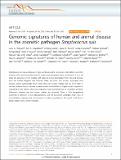Genomic signatures of human and animal disease in the zoonotic pathogen Streptococcus suis
Abstract
Streptococcus suis causes disease in pigs worldwide and is increasingly implicated in zoonotic disease in East and South-East Asia. To understand the genetic basis of disease in S. suis, we study the genomes of 375 isolates with detailed clinical phenotypes from pigs and humans from the United Kingdom and Vietnam. Here, we show that isolates associated with disease contain substantially fewer genes than non-clinical isolates, but are more likely to encode virulence factors. Human disease isolates are limited to a single-virulent population, originating in the 1920s when pig production was intensified, but no consistent genomic differences between pig and human isolates are observed. There is little geographical clustering of different S. suis subpopulations, and the bacterium undergoes high rates of recombination, implying that an increase in virulence anywhere in the world could have a global impact over a short timescale.
Citation
Weinert , L A , Chaudhuri , R R , Wang , J , Peters , S E , Corander , J , Jombart , T , Baig , A , Howell , K J , Vehkala , M , Välimäki , N , Harris , D , Chieu , T T B , Van Vinh Chau , N , Campbell , J , Schultsz , C , Parkhill , J , Bentley , S D , Langford , P R , Rycroft , A N , Wren , B W , Farrar , J , Baker , S , Hoa , N T , Holden , M T G , Tucker , A W , Maskell , D J & BRaDP1T Consortium 2015 , ' Genomic signatures of human and animal disease in the zoonotic pathogen Streptococcus suis ' , Nature Communications , vol. 6 , 6740 . https://doi.org/10.1038/ncomms7740
Publication
Nature Communications
Status
Peer reviewed
ISSN
2041-1723Type
Journal article
Description
This work was supported by a Longer and Larger (LoLa) grant from the Biotechnology and Biological Sciences Research Council (grant numbers BB/G020744/1, BB/G019177/1, BB/G019274/1 and BB/G003203/1), the UK Department for Environment, Food and Rural Affairs and Zoetis, awarded to the Bacterial Respiratory Diseases of Pigs: 1 Technology (BRaDP1T) consortium. Part of this work was supported by The Wellcome Trust Overseas Programme in Vietnam (2010–2015) (089276/Z/09/Z) and the Vietnam Initiative on Zoonotic Infections (VIZIONS) award (WT/093724/Z/10/Z). S.D.B. is partly funded by the NIHR Cambridge BRC.Collections
Items in the St Andrews Research Repository are protected by copyright, with all rights reserved, unless otherwise indicated.

